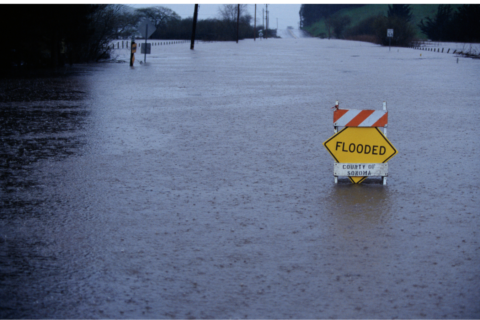Communities across the country are recognizing the importance of investing in climate-resilient infrastructure — and the federal government is emphasizing this need, too. In September 2023, the White House released its National Climate Resilience Framework noting that:
Building climate-resilient communities will require developing capacity to respond to emergencies — including multiple concurrent emergencies — as well as far greater efforts to reduce risks and make long-term investments in resilient structures and infrastructure.
As climate change continues to impact the built environment, more city leaders are prioritizing climate-resilient infrastructure during both planning and implementation. To explore the state of resilient infrastructure and spotlight success stories from across the country, National League of Cities released the brief “Building Resilient Infrastructure for Healthier, Safer Cities.” The brief focuses on the three infrastructure areas that NLC’s 2023 State of the Cities report identifies as top mayoral priorities: streets and transportation; water and wastewater management; and broadband and telecommunications. The following summarizes the brief’s core themes and highlights additional tools and funding opportunities for improving municipal infrastructure resilience.”
Getting Started: Developing a Comprehensive Approach for Climate Resilience
While there are many ways to approach climate resilience, an All-of-Government approach has proven to be effective in ensuring infrastructure is built to withstand extreme weather events, last its intended design life and maintain safety and reliability. An All-of-Government approach refers to collaborative work across government agencies and administrations to address major problems that require multiple perspectives and expertise to solve. This method recognizes that the most effective way to build climate resilience is for everyone to be involved. Many local governments are beginning to use this approach to center climate resilience in design standards for all major infrastructure projects. For local leaders examining ways to integrate climate resilience into their internal processes, essential first steps include:
- Creating an internal city commitment to climate resilience and establishing clearly defined goals
- Embedding climate resilience as a central lens in existing workflows
- Using data to understand climate risk over the lifecycle of major infrastructure projects to make the right financial choices to ensure the project functions as intended throughout its design life
Key Considerations to Improve Resiliency for Critical Infrastructure

To improve infrastructure’s climate resilience, local leaders should make climate considerations central to planning and implementation efforts when building new and renovating existing infrastructure. Three major areas of infrastructure included in the brief are:
Streets and Transportation. Functional transportation systems are critical for emergency service provision, evacuation and access to healthcare during a crisis. Flooding, winter storms and heat can all compromise transportation systems and risk the health and wellbeing of people using streets and public spaces during an extreme weather event. Investing in resilient street and transportation infrastructure will support these systems’ continued function during a weather emergency and provide a range of environmental, public health and economic benefits the rest of the time.
Key strategies to support resilient streets and transportation systems include assessing areas of greatest risk and prioritizing investments that alleviate pressure on high use corridors and fund resilience in areas with a legacy of disinvestment. It is also imperative to increase green infrastructure and solar reflective surfaces in vulnerable areas and build resiliency considerations into ADA transition plans and other accessibility planning.

Water and Wastewater Treatment. Centralized water and wastewater management systems, on-site wastewater treatment infrastructure and on-site wells face heightened risks of failure and contamination as climate conditions change. By updating design standards for new infrastructure and retrofitting existing assets, local governments and utilities can increase the likelihood of uninterrupted delivery of clean water and effective wastewater treatment, prevent waterborne diseases and environmental pollution and extend the design life of major infrastructure projects.
Key strategies to advance resilient water and wastewater infrastructure include understanding climate risk to the proposed site or existing asset to identify appropriate solutions, such as elevating critical infrastructure or critical elements of infrastructure in areas prone to flooding.

Broadband and Telecommunications. Investing in resilient, equitable broadband and telecommunications infrastructure is essential to ensuring communication channels and access to information remain available during and after a crisis event.
Key strategies include ensuring emergency response priority plans are set to get lines restored efficiently after a disaster, critical infrastructure is not located in high-risk zones, protocols are created for regular audits of telecommunications towers and cell sites that ensure structural integrity and preventative maintenance is conducted.

While streets and transportation, water and wastewater treatment and broadband and telecommunications were cited as top priorities for cities, these are not the only areas of concern for cities working on improving the resiliency of their infrastructure. Housing and other building types also warrant consideration. NLC’s resources on making housing infrastructure resilient, combatting the effects of climate change on healthy housing, federal funding opportunities for resilient affordable housing and using FEMA’s BRIC program to update building codes can help cities start thinking about how to improve their housing and building infrastructure’s resilience to climate change.
Tools to Protect Your Infrastructure Today and in the Future
Take the first step to assess infrastructure risk in your municipality, identify your priorities and solutions and find funding to protect and build resilient infrastructure to serve your communities.
Unprecedented levels of federal funding are available to protect and enhance infrastructure. Check out the Rebuilding America: Tracking Federal Investment in Local Infrastructure Projects dashboard, ARPA Sustainability & Climate Resilience Fact Sheet and how communities are using Bipartisan Infrastructure Law funding for climate action to explore federal funding opportunities for resilient infrastructure.
For tools and research to advance municipal resilient infrastructure planning, explore free federal resources including the Community Resilience Toolkit from the U.S. Department of Housing and Urban Development, the U.S. Climate Resilience Toolkit produced by the National Oceanic and Atmospheric Administration and partners, Heat.gov created by the National Integrated Heat Health Information System and partners and the White House’s National Climate Resilience Framework, including Opportunities for Action beginning on page 9.
Finally, reach out to local networks and consortiums working on climate resilience — they may have local tools and data to support your community as you plan for the future.











